Change Management in Health & Social Care Services UK
VerifiedAdded on 2024/06/07
|22
|5649
|96
Report
AI Summary
This assignment provides a detailed analysis of the factors driving change in the health and social care sector, with a focus on the UK context. It examines political, economic, social, technological, legal, and demographic factors and assesses the challenges these changes pose to healthcare organizations. The report also devises strategies for measuring recent changes in health and social care and evaluates their impact on service delivery, employee performance, and patient outcomes. Using the Nuffield Trust as an example, the assignment explores change management principles and highlights the importance of adapting to evolving healthcare landscapes. Desklib provides access to this assignment and many other study resources.
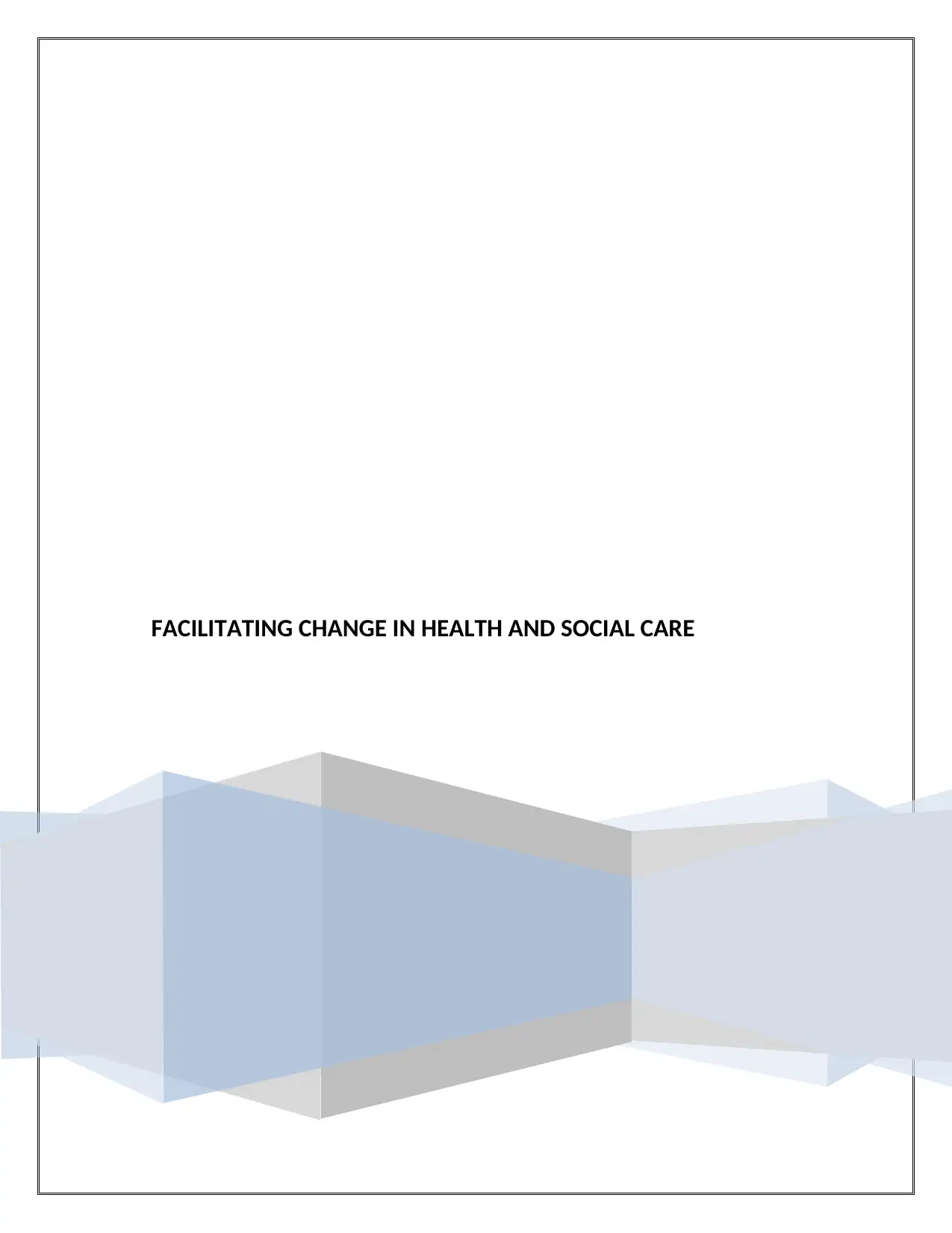
FACILITATING CHANGE IN HEALTH AND SOCIAL CARE
Paraphrase This Document
Need a fresh take? Get an instant paraphrase of this document with our AI Paraphraser
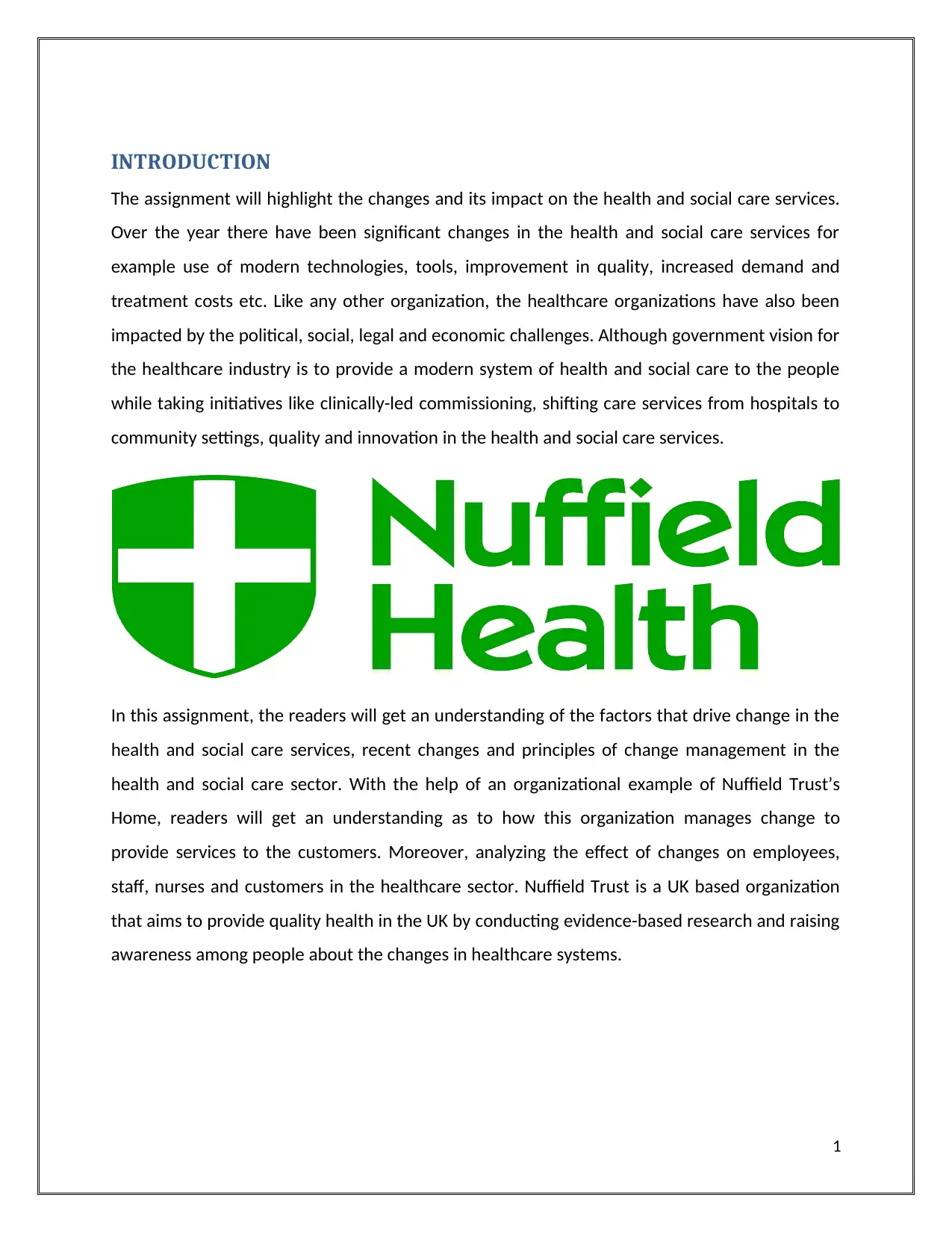
INTRODUCTION
The assignment will highlight the changes and its impact on the health and social care services.
Over the year there have been significant changes in the health and social care services for
example use of modern technologies, tools, improvement in quality, increased demand and
treatment costs etc. Like any other organization, the healthcare organizations have also been
impacted by the political, social, legal and economic challenges. Although government vision for
the healthcare industry is to provide a modern system of health and social care to the people
while taking initiatives like clinically-led commissioning, shifting care services from hospitals to
community settings, quality and innovation in the health and social care services.
In this assignment, the readers will get an understanding of the factors that drive change in the
health and social care services, recent changes and principles of change management in the
health and social care sector. With the help of an organizational example of Nuffield Trust’s
Home, readers will get an understanding as to how this organization manages change to
provide services to the customers. Moreover, analyzing the effect of changes on employees,
staff, nurses and customers in the healthcare sector. Nuffield Trust is a UK based organization
that aims to provide quality health in the UK by conducting evidence-based research and raising
awareness among people about the changes in healthcare systems.
1
The assignment will highlight the changes and its impact on the health and social care services.
Over the year there have been significant changes in the health and social care services for
example use of modern technologies, tools, improvement in quality, increased demand and
treatment costs etc. Like any other organization, the healthcare organizations have also been
impacted by the political, social, legal and economic challenges. Although government vision for
the healthcare industry is to provide a modern system of health and social care to the people
while taking initiatives like clinically-led commissioning, shifting care services from hospitals to
community settings, quality and innovation in the health and social care services.
In this assignment, the readers will get an understanding of the factors that drive change in the
health and social care services, recent changes and principles of change management in the
health and social care sector. With the help of an organizational example of Nuffield Trust’s
Home, readers will get an understanding as to how this organization manages change to
provide services to the customers. Moreover, analyzing the effect of changes on employees,
staff, nurses and customers in the healthcare sector. Nuffield Trust is a UK based organization
that aims to provide quality health in the UK by conducting evidence-based research and raising
awareness among people about the changes in healthcare systems.
1
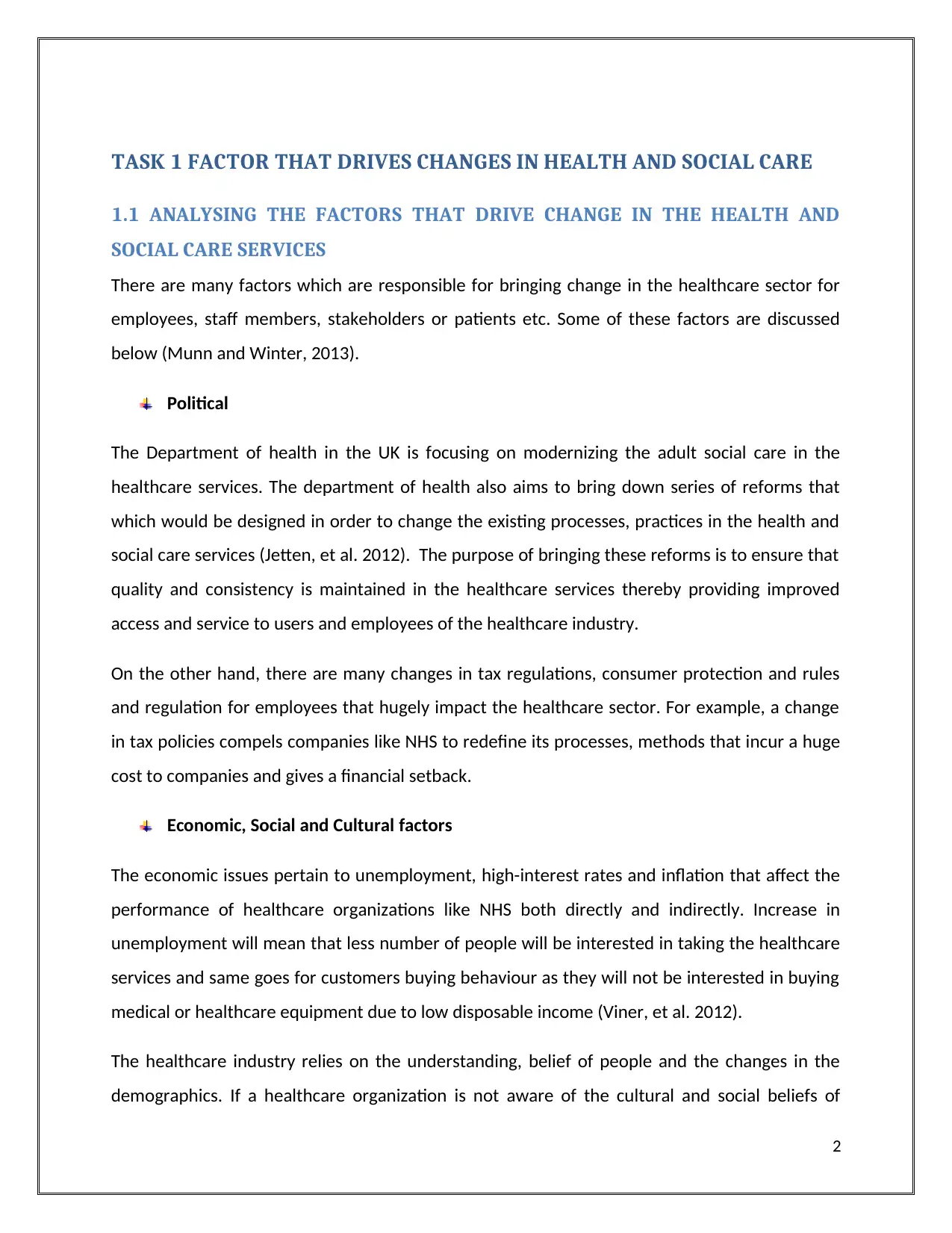
TASK 1 FACTOR THAT DRIVES CHANGES IN HEALTH AND SOCIAL CARE
1.1 ANALYSING THE FACTORS THAT DRIVE CHANGE IN THE HEALTH AND
SOCIAL CARE SERVICES
There are many factors which are responsible for bringing change in the healthcare sector for
employees, staff members, stakeholders or patients etc. Some of these factors are discussed
below (Munn and Winter, 2013).
Political
The Department of health in the UK is focusing on modernizing the adult social care in the
healthcare services. The department of health also aims to bring down series of reforms that
which would be designed in order to change the existing processes, practices in the health and
social care services (Jetten, et al. 2012). The purpose of bringing these reforms is to ensure that
quality and consistency is maintained in the healthcare services thereby providing improved
access and service to users and employees of the healthcare industry.
On the other hand, there are many changes in tax regulations, consumer protection and rules
and regulation for employees that hugely impact the healthcare sector. For example, a change
in tax policies compels companies like NHS to redefine its processes, methods that incur a huge
cost to companies and gives a financial setback.
Economic, Social and Cultural factors
The economic issues pertain to unemployment, high-interest rates and inflation that affect the
performance of healthcare organizations like NHS both directly and indirectly. Increase in
unemployment will mean that less number of people will be interested in taking the healthcare
services and same goes for customers buying behaviour as they will not be interested in buying
medical or healthcare equipment due to low disposable income (Viner, et al. 2012).
The healthcare industry relies on the understanding, belief of people and the changes in the
demographics. If a healthcare organization is not aware of the cultural and social beliefs of
2
1.1 ANALYSING THE FACTORS THAT DRIVE CHANGE IN THE HEALTH AND
SOCIAL CARE SERVICES
There are many factors which are responsible for bringing change in the healthcare sector for
employees, staff members, stakeholders or patients etc. Some of these factors are discussed
below (Munn and Winter, 2013).
Political
The Department of health in the UK is focusing on modernizing the adult social care in the
healthcare services. The department of health also aims to bring down series of reforms that
which would be designed in order to change the existing processes, practices in the health and
social care services (Jetten, et al. 2012). The purpose of bringing these reforms is to ensure that
quality and consistency is maintained in the healthcare services thereby providing improved
access and service to users and employees of the healthcare industry.
On the other hand, there are many changes in tax regulations, consumer protection and rules
and regulation for employees that hugely impact the healthcare sector. For example, a change
in tax policies compels companies like NHS to redefine its processes, methods that incur a huge
cost to companies and gives a financial setback.
Economic, Social and Cultural factors
The economic issues pertain to unemployment, high-interest rates and inflation that affect the
performance of healthcare organizations like NHS both directly and indirectly. Increase in
unemployment will mean that less number of people will be interested in taking the healthcare
services and same goes for customers buying behaviour as they will not be interested in buying
medical or healthcare equipment due to low disposable income (Viner, et al. 2012).
The healthcare industry relies on the understanding, belief of people and the changes in the
demographics. If a healthcare organization is not aware of the cultural and social beliefs of
2
⊘ This is a preview!⊘
Do you want full access?
Subscribe today to unlock all pages.

Trusted by 1+ million students worldwide
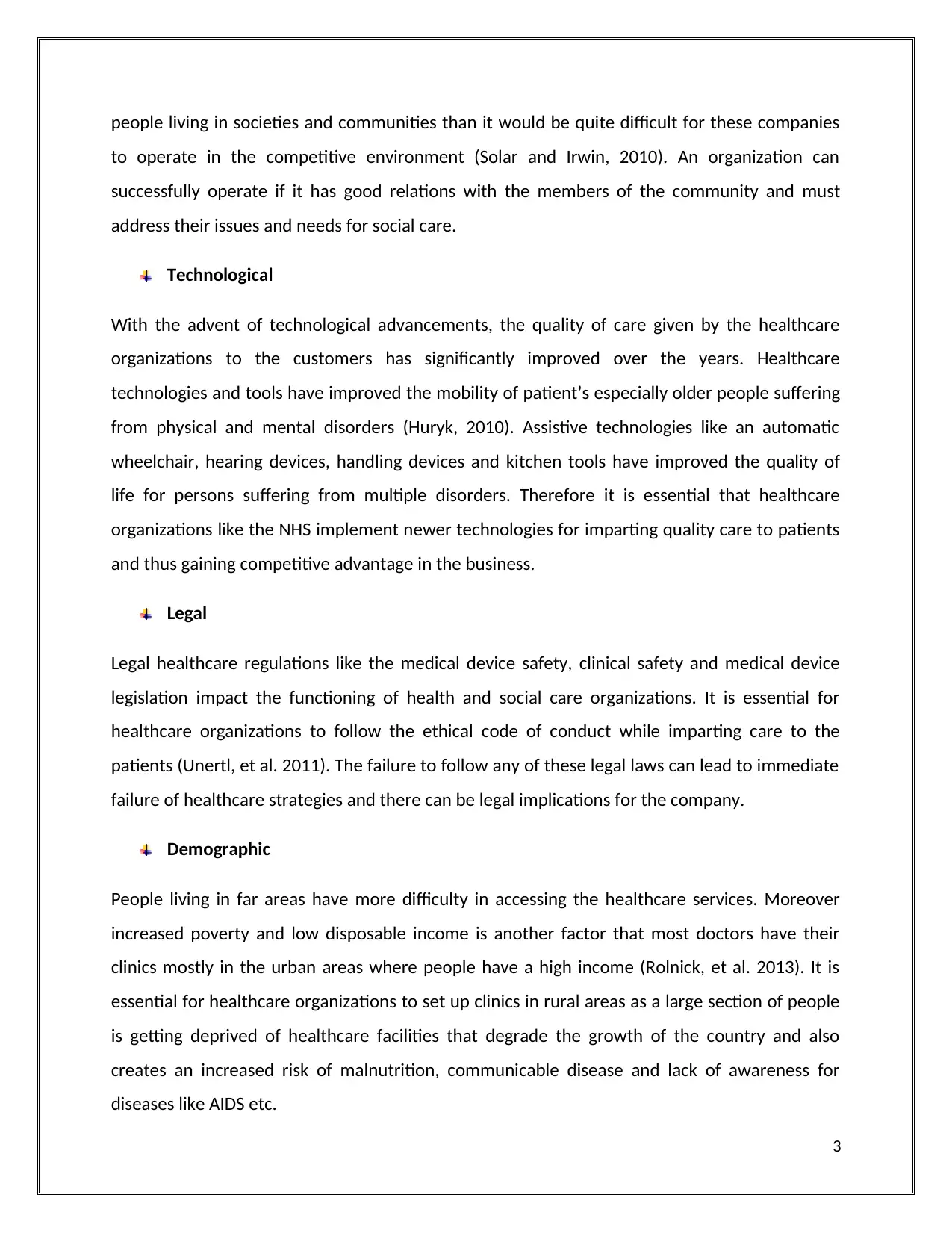
people living in societies and communities than it would be quite difficult for these companies
to operate in the competitive environment (Solar and Irwin, 2010). An organization can
successfully operate if it has good relations with the members of the community and must
address their issues and needs for social care.
Technological
With the advent of technological advancements, the quality of care given by the healthcare
organizations to the customers has significantly improved over the years. Healthcare
technologies and tools have improved the mobility of patient’s especially older people suffering
from physical and mental disorders (Huryk, 2010). Assistive technologies like an automatic
wheelchair, hearing devices, handling devices and kitchen tools have improved the quality of
life for persons suffering from multiple disorders. Therefore it is essential that healthcare
organizations like the NHS implement newer technologies for imparting quality care to patients
and thus gaining competitive advantage in the business.
Legal
Legal healthcare regulations like the medical device safety, clinical safety and medical device
legislation impact the functioning of health and social care organizations. It is essential for
healthcare organizations to follow the ethical code of conduct while imparting care to the
patients (Unertl, et al. 2011). The failure to follow any of these legal laws can lead to immediate
failure of healthcare strategies and there can be legal implications for the company.
Demographic
People living in far areas have more difficulty in accessing the healthcare services. Moreover
increased poverty and low disposable income is another factor that most doctors have their
clinics mostly in the urban areas where people have a high income (Rolnick, et al. 2013). It is
essential for healthcare organizations to set up clinics in rural areas as a large section of people
is getting deprived of healthcare facilities that degrade the growth of the country and also
creates an increased risk of malnutrition, communicable disease and lack of awareness for
diseases like AIDS etc.
3
to operate in the competitive environment (Solar and Irwin, 2010). An organization can
successfully operate if it has good relations with the members of the community and must
address their issues and needs for social care.
Technological
With the advent of technological advancements, the quality of care given by the healthcare
organizations to the customers has significantly improved over the years. Healthcare
technologies and tools have improved the mobility of patient’s especially older people suffering
from physical and mental disorders (Huryk, 2010). Assistive technologies like an automatic
wheelchair, hearing devices, handling devices and kitchen tools have improved the quality of
life for persons suffering from multiple disorders. Therefore it is essential that healthcare
organizations like the NHS implement newer technologies for imparting quality care to patients
and thus gaining competitive advantage in the business.
Legal
Legal healthcare regulations like the medical device safety, clinical safety and medical device
legislation impact the functioning of health and social care organizations. It is essential for
healthcare organizations to follow the ethical code of conduct while imparting care to the
patients (Unertl, et al. 2011). The failure to follow any of these legal laws can lead to immediate
failure of healthcare strategies and there can be legal implications for the company.
Demographic
People living in far areas have more difficulty in accessing the healthcare services. Moreover
increased poverty and low disposable income is another factor that most doctors have their
clinics mostly in the urban areas where people have a high income (Rolnick, et al. 2013). It is
essential for healthcare organizations to set up clinics in rural areas as a large section of people
is getting deprived of healthcare facilities that degrade the growth of the country and also
creates an increased risk of malnutrition, communicable disease and lack of awareness for
diseases like AIDS etc.
3
Paraphrase This Document
Need a fresh take? Get an instant paraphrase of this document with our AI Paraphraser
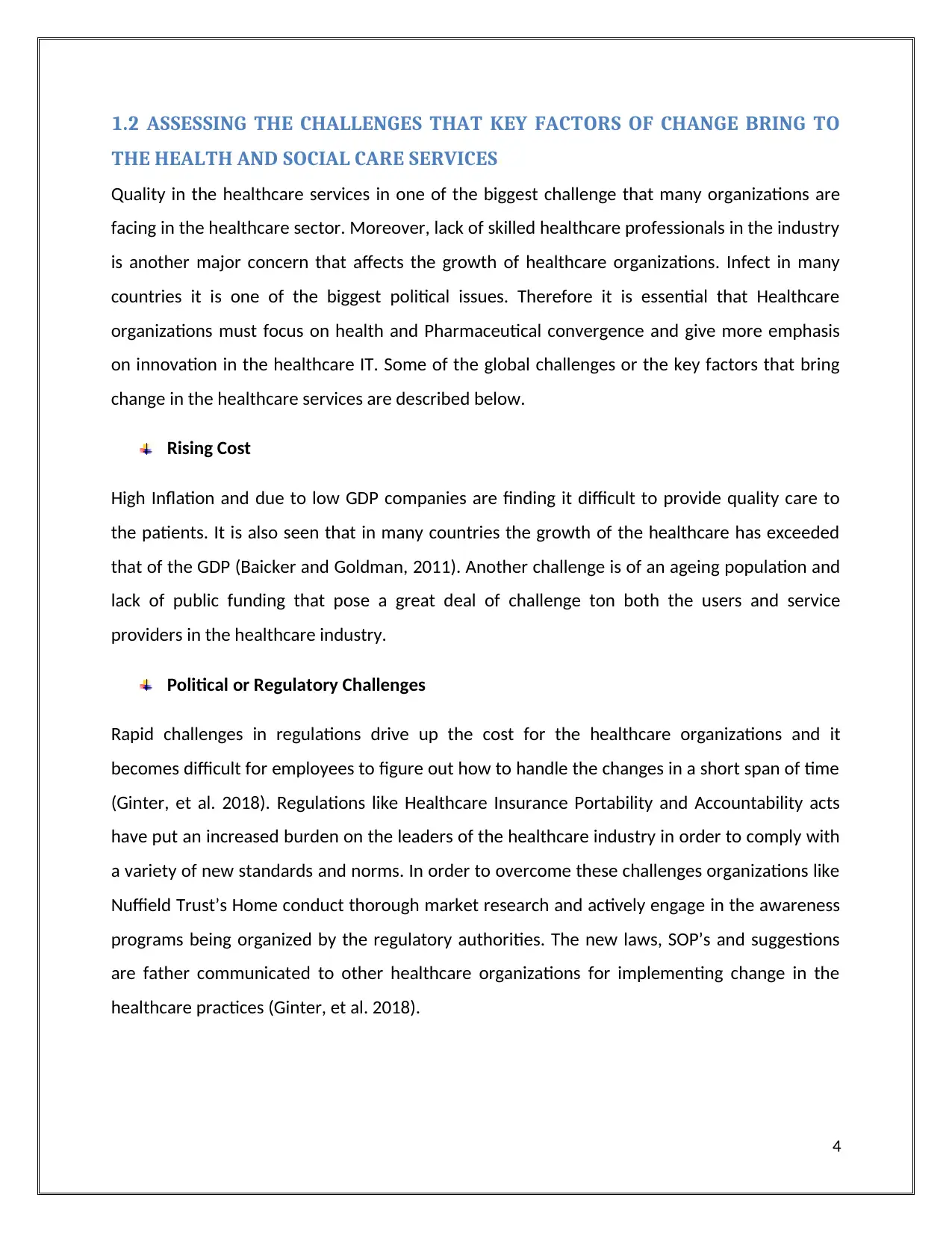
1.2 ASSESSING THE CHALLENGES THAT KEY FACTORS OF CHANGE BRING TO
THE HEALTH AND SOCIAL CARE SERVICES
Quality in the healthcare services in one of the biggest challenge that many organizations are
facing in the healthcare sector. Moreover, lack of skilled healthcare professionals in the industry
is another major concern that affects the growth of healthcare organizations. Infect in many
countries it is one of the biggest political issues. Therefore it is essential that Healthcare
organizations must focus on health and Pharmaceutical convergence and give more emphasis
on innovation in the healthcare IT. Some of the global challenges or the key factors that bring
change in the healthcare services are described below.
Rising Cost
High Inflation and due to low GDP companies are finding it difficult to provide quality care to
the patients. It is also seen that in many countries the growth of the healthcare has exceeded
that of the GDP (Baicker and Goldman, 2011). Another challenge is of an ageing population and
lack of public funding that pose a great deal of challenge ton both the users and service
providers in the healthcare industry.
Political or Regulatory Challenges
Rapid challenges in regulations drive up the cost for the healthcare organizations and it
becomes difficult for employees to figure out how to handle the changes in a short span of time
(Ginter, et al. 2018). Regulations like Healthcare Insurance Portability and Accountability acts
have put an increased burden on the leaders of the healthcare industry in order to comply with
a variety of new standards and norms. In order to overcome these challenges organizations like
Nuffield Trust’s Home conduct thorough market research and actively engage in the awareness
programs being organized by the regulatory authorities. The new laws, SOP’s and suggestions
are father communicated to other healthcare organizations for implementing change in the
healthcare practices (Ginter, et al. 2018).
4
THE HEALTH AND SOCIAL CARE SERVICES
Quality in the healthcare services in one of the biggest challenge that many organizations are
facing in the healthcare sector. Moreover, lack of skilled healthcare professionals in the industry
is another major concern that affects the growth of healthcare organizations. Infect in many
countries it is one of the biggest political issues. Therefore it is essential that Healthcare
organizations must focus on health and Pharmaceutical convergence and give more emphasis
on innovation in the healthcare IT. Some of the global challenges or the key factors that bring
change in the healthcare services are described below.
Rising Cost
High Inflation and due to low GDP companies are finding it difficult to provide quality care to
the patients. It is also seen that in many countries the growth of the healthcare has exceeded
that of the GDP (Baicker and Goldman, 2011). Another challenge is of an ageing population and
lack of public funding that pose a great deal of challenge ton both the users and service
providers in the healthcare industry.
Political or Regulatory Challenges
Rapid challenges in regulations drive up the cost for the healthcare organizations and it
becomes difficult for employees to figure out how to handle the changes in a short span of time
(Ginter, et al. 2018). Regulations like Healthcare Insurance Portability and Accountability acts
have put an increased burden on the leaders of the healthcare industry in order to comply with
a variety of new standards and norms. In order to overcome these challenges organizations like
Nuffield Trust’s Home conduct thorough market research and actively engage in the awareness
programs being organized by the regulatory authorities. The new laws, SOP’s and suggestions
are father communicated to other healthcare organizations for implementing change in the
healthcare practices (Ginter, et al. 2018).
4
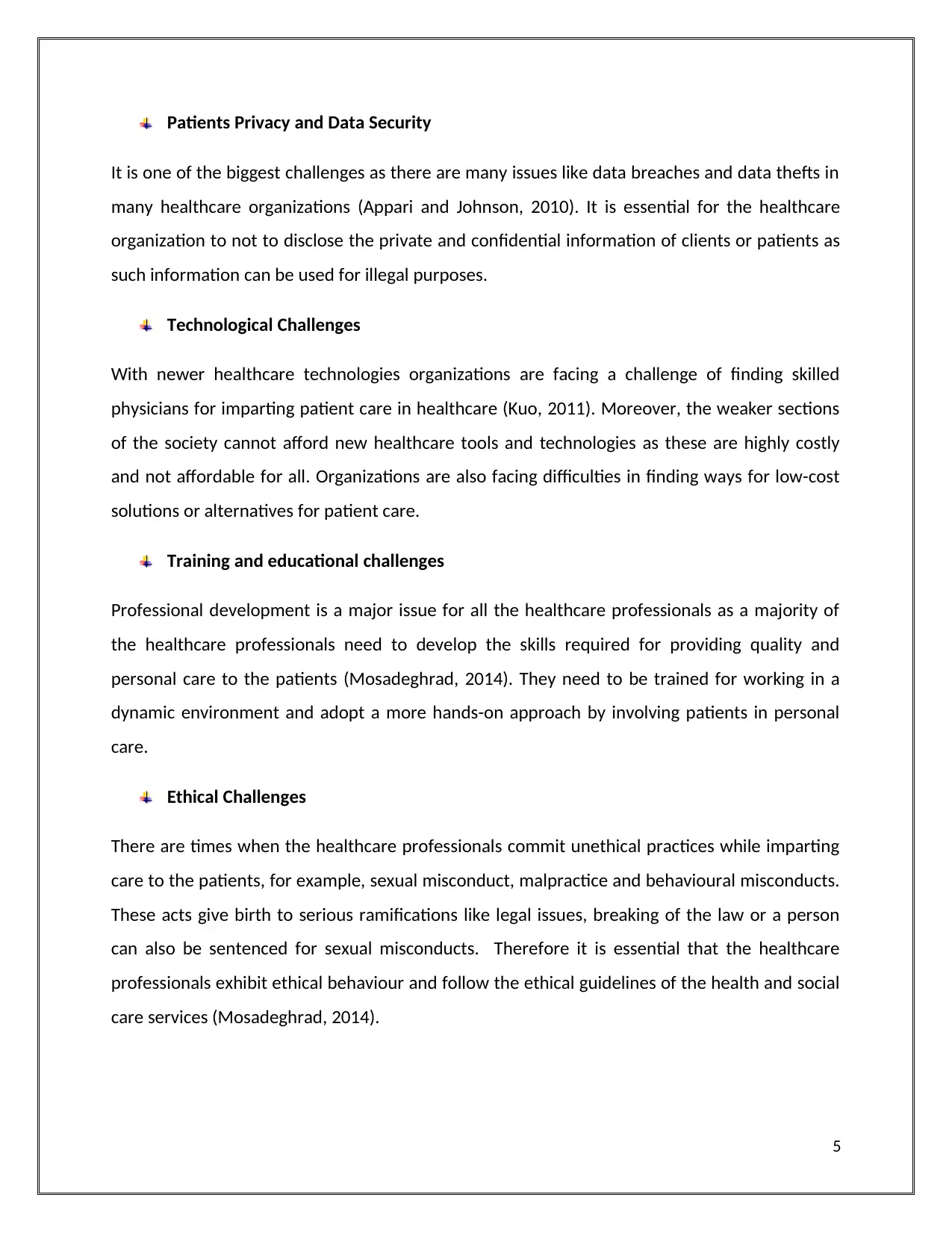
Patients Privacy and Data Security
It is one of the biggest challenges as there are many issues like data breaches and data thefts in
many healthcare organizations (Appari and Johnson, 2010). It is essential for the healthcare
organization to not to disclose the private and confidential information of clients or patients as
such information can be used for illegal purposes.
Technological Challenges
With newer healthcare technologies organizations are facing a challenge of finding skilled
physicians for imparting patient care in healthcare (Kuo, 2011). Moreover, the weaker sections
of the society cannot afford new healthcare tools and technologies as these are highly costly
and not affordable for all. Organizations are also facing difficulties in finding ways for low-cost
solutions or alternatives for patient care.
Training and educational challenges
Professional development is a major issue for all the healthcare professionals as a majority of
the healthcare professionals need to develop the skills required for providing quality and
personal care to the patients (Mosadeghrad, 2014). They need to be trained for working in a
dynamic environment and adopt a more hands-on approach by involving patients in personal
care.
Ethical Challenges
There are times when the healthcare professionals commit unethical practices while imparting
care to the patients, for example, sexual misconduct, malpractice and behavioural misconducts.
These acts give birth to serious ramifications like legal issues, breaking of the law or a person
can also be sentenced for sexual misconducts. Therefore it is essential that the healthcare
professionals exhibit ethical behaviour and follow the ethical guidelines of the health and social
care services (Mosadeghrad, 2014).
5
It is one of the biggest challenges as there are many issues like data breaches and data thefts in
many healthcare organizations (Appari and Johnson, 2010). It is essential for the healthcare
organization to not to disclose the private and confidential information of clients or patients as
such information can be used for illegal purposes.
Technological Challenges
With newer healthcare technologies organizations are facing a challenge of finding skilled
physicians for imparting patient care in healthcare (Kuo, 2011). Moreover, the weaker sections
of the society cannot afford new healthcare tools and technologies as these are highly costly
and not affordable for all. Organizations are also facing difficulties in finding ways for low-cost
solutions or alternatives for patient care.
Training and educational challenges
Professional development is a major issue for all the healthcare professionals as a majority of
the healthcare professionals need to develop the skills required for providing quality and
personal care to the patients (Mosadeghrad, 2014). They need to be trained for working in a
dynamic environment and adopt a more hands-on approach by involving patients in personal
care.
Ethical Challenges
There are times when the healthcare professionals commit unethical practices while imparting
care to the patients, for example, sexual misconduct, malpractice and behavioural misconducts.
These acts give birth to serious ramifications like legal issues, breaking of the law or a person
can also be sentenced for sexual misconducts. Therefore it is essential that the healthcare
professionals exhibit ethical behaviour and follow the ethical guidelines of the health and social
care services (Mosadeghrad, 2014).
5
⊘ This is a preview!⊘
Do you want full access?
Subscribe today to unlock all pages.

Trusted by 1+ million students worldwide
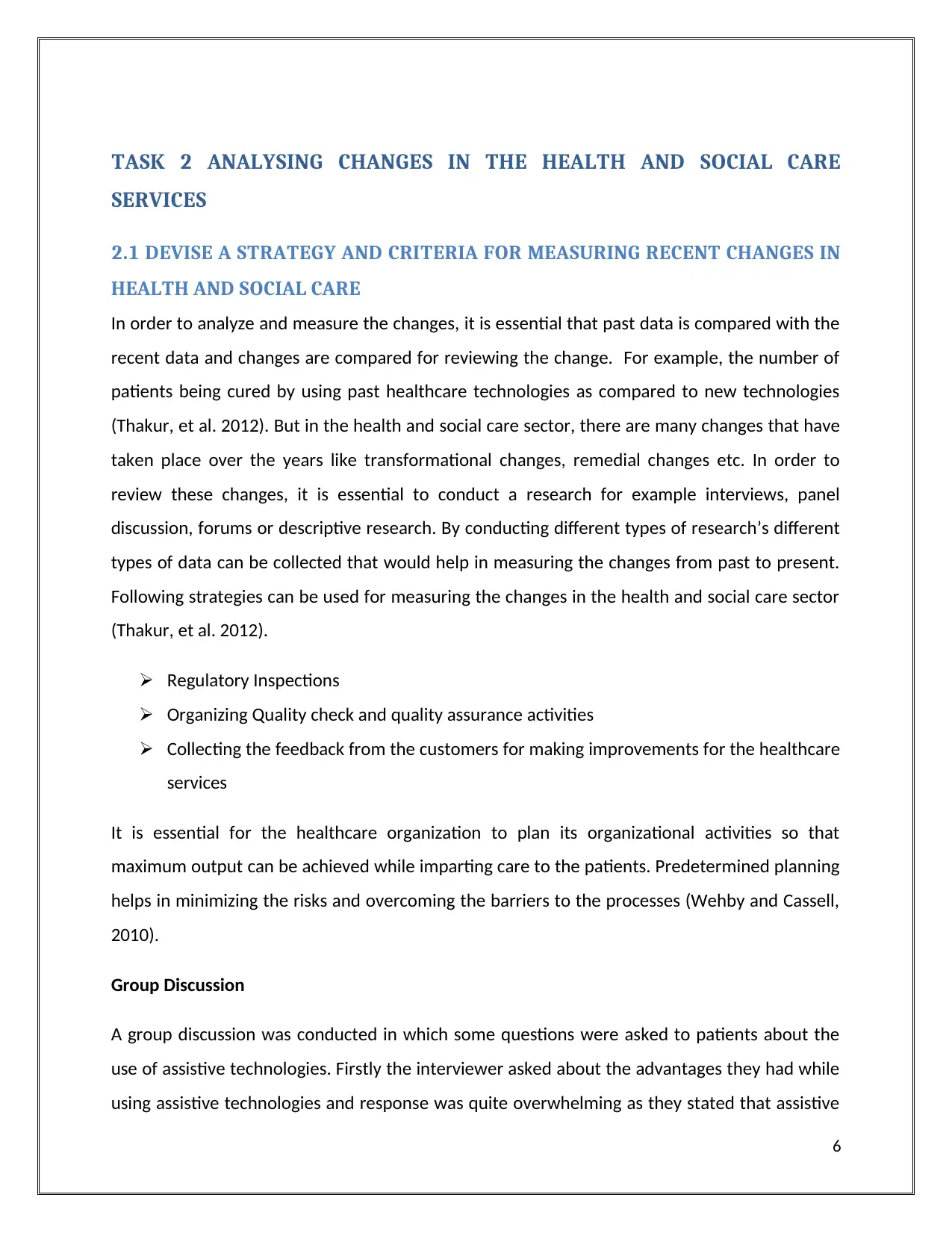
TASK 2 ANALYSING CHANGES IN THE HEALTH AND SOCIAL CARE
SERVICES
2.1 DEVISE A STRATEGY AND CRITERIA FOR MEASURING RECENT CHANGES IN
HEALTH AND SOCIAL CARE
In order to analyze and measure the changes, it is essential that past data is compared with the
recent data and changes are compared for reviewing the change. For example, the number of
patients being cured by using past healthcare technologies as compared to new technologies
(Thakur, et al. 2012). But in the health and social care sector, there are many changes that have
taken place over the years like transformational changes, remedial changes etc. In order to
review these changes, it is essential to conduct a research for example interviews, panel
discussion, forums or descriptive research. By conducting different types of research’s different
types of data can be collected that would help in measuring the changes from past to present.
Following strategies can be used for measuring the changes in the health and social care sector
(Thakur, et al. 2012).
Regulatory Inspections
Organizing Quality check and quality assurance activities
Collecting the feedback from the customers for making improvements for the healthcare
services
It is essential for the healthcare organization to plan its organizational activities so that
maximum output can be achieved while imparting care to the patients. Predetermined planning
helps in minimizing the risks and overcoming the barriers to the processes (Wehby and Cassell,
2010).
Group Discussion
A group discussion was conducted in which some questions were asked to patients about the
use of assistive technologies. Firstly the interviewer asked about the advantages they had while
using assistive technologies and response was quite overwhelming as they stated that assistive
6
SERVICES
2.1 DEVISE A STRATEGY AND CRITERIA FOR MEASURING RECENT CHANGES IN
HEALTH AND SOCIAL CARE
In order to analyze and measure the changes, it is essential that past data is compared with the
recent data and changes are compared for reviewing the change. For example, the number of
patients being cured by using past healthcare technologies as compared to new technologies
(Thakur, et al. 2012). But in the health and social care sector, there are many changes that have
taken place over the years like transformational changes, remedial changes etc. In order to
review these changes, it is essential to conduct a research for example interviews, panel
discussion, forums or descriptive research. By conducting different types of research’s different
types of data can be collected that would help in measuring the changes from past to present.
Following strategies can be used for measuring the changes in the health and social care sector
(Thakur, et al. 2012).
Regulatory Inspections
Organizing Quality check and quality assurance activities
Collecting the feedback from the customers for making improvements for the healthcare
services
It is essential for the healthcare organization to plan its organizational activities so that
maximum output can be achieved while imparting care to the patients. Predetermined planning
helps in minimizing the risks and overcoming the barriers to the processes (Wehby and Cassell,
2010).
Group Discussion
A group discussion was conducted in which some questions were asked to patients about the
use of assistive technologies. Firstly the interviewer asked about the advantages they had while
using assistive technologies and response was quite overwhelming as they stated that assistive
6
Paraphrase This Document
Need a fresh take? Get an instant paraphrase of this document with our AI Paraphraser
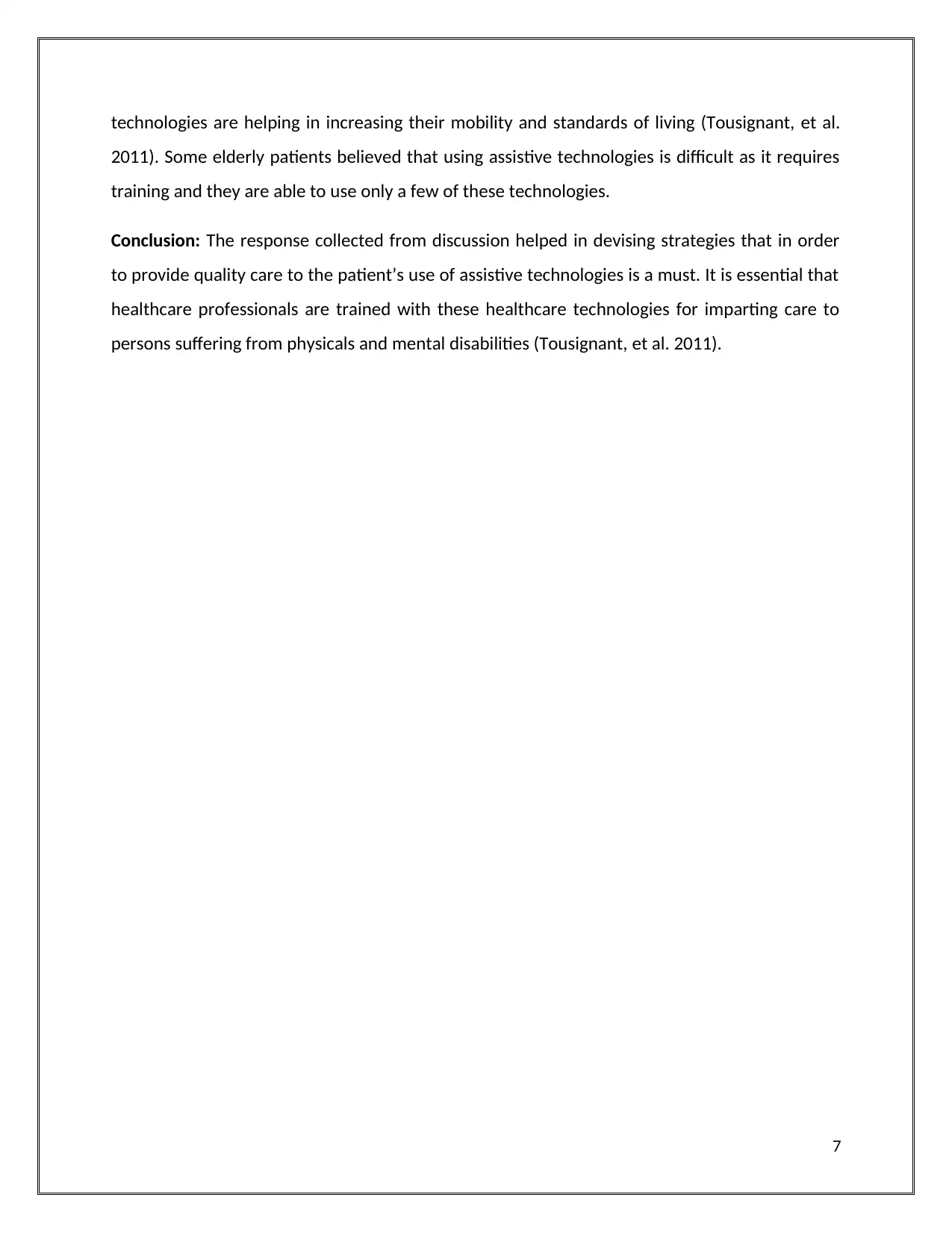
technologies are helping in increasing their mobility and standards of living (Tousignant, et al.
2011). Some elderly patients believed that using assistive technologies is difficult as it requires
training and they are able to use only a few of these technologies.
Conclusion: The response collected from discussion helped in devising strategies that in order
to provide quality care to the patient’s use of assistive technologies is a must. It is essential that
healthcare professionals are trained with these healthcare technologies for imparting care to
persons suffering from physicals and mental disabilities (Tousignant, et al. 2011).
7
2011). Some elderly patients believed that using assistive technologies is difficult as it requires
training and they are able to use only a few of these technologies.
Conclusion: The response collected from discussion helped in devising strategies that in order
to provide quality care to the patient’s use of assistive technologies is a must. It is essential that
healthcare professionals are trained with these healthcare technologies for imparting care to
persons suffering from physicals and mental disabilities (Tousignant, et al. 2011).
7
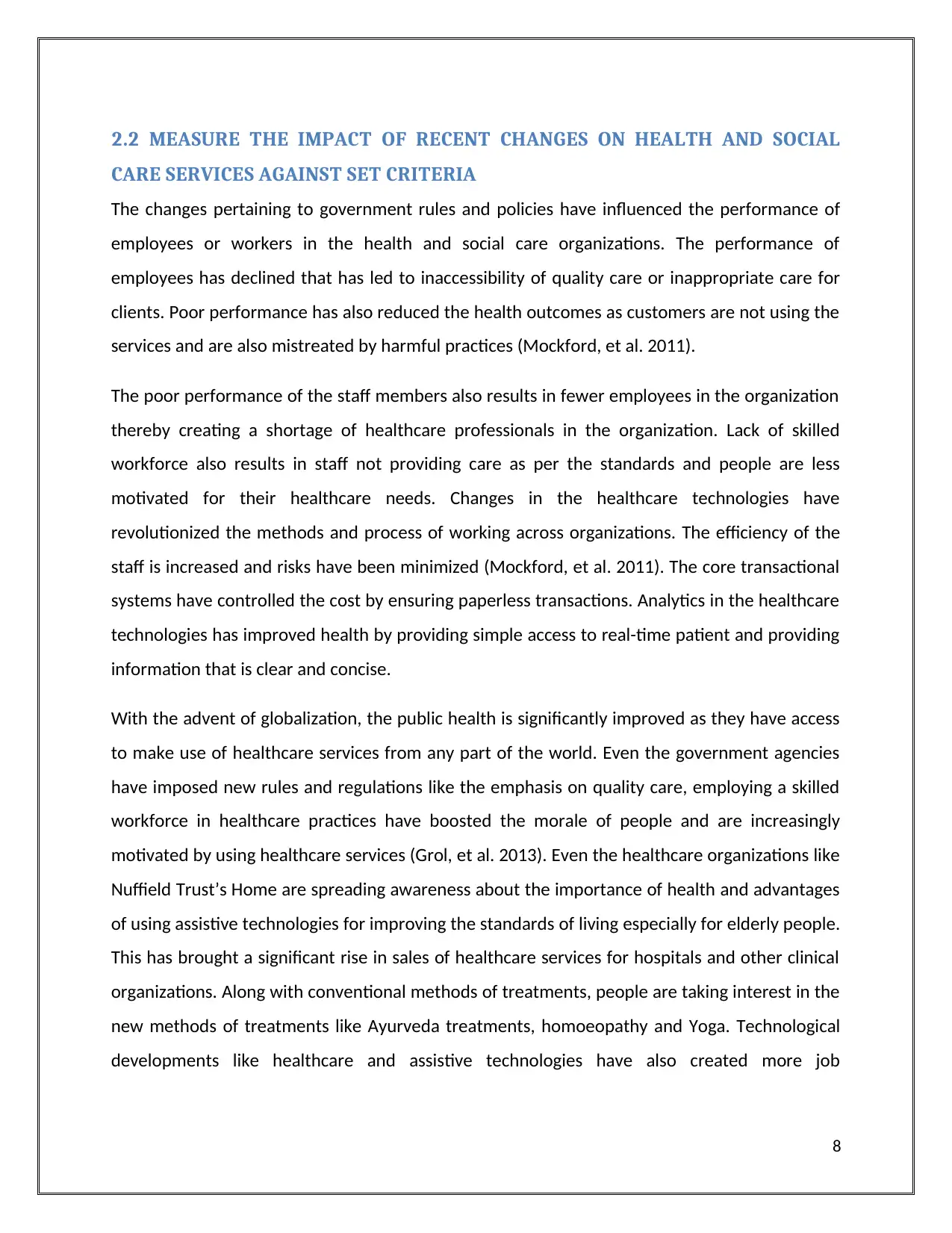
2.2 MEASURE THE IMPACT OF RECENT CHANGES ON HEALTH AND SOCIAL
CARE SERVICES AGAINST SET CRITERIA
The changes pertaining to government rules and policies have influenced the performance of
employees or workers in the health and social care organizations. The performance of
employees has declined that has led to inaccessibility of quality care or inappropriate care for
clients. Poor performance has also reduced the health outcomes as customers are not using the
services and are also mistreated by harmful practices (Mockford, et al. 2011).
The poor performance of the staff members also results in fewer employees in the organization
thereby creating a shortage of healthcare professionals in the organization. Lack of skilled
workforce also results in staff not providing care as per the standards and people are less
motivated for their healthcare needs. Changes in the healthcare technologies have
revolutionized the methods and process of working across organizations. The efficiency of the
staff is increased and risks have been minimized (Mockford, et al. 2011). The core transactional
systems have controlled the cost by ensuring paperless transactions. Analytics in the healthcare
technologies has improved health by providing simple access to real-time patient and providing
information that is clear and concise.
With the advent of globalization, the public health is significantly improved as they have access
to make use of healthcare services from any part of the world. Even the government agencies
have imposed new rules and regulations like the emphasis on quality care, employing a skilled
workforce in healthcare practices have boosted the morale of people and are increasingly
motivated by using healthcare services (Grol, et al. 2013). Even the healthcare organizations like
Nuffield Trust’s Home are spreading awareness about the importance of health and advantages
of using assistive technologies for improving the standards of living especially for elderly people.
This has brought a significant rise in sales of healthcare services for hospitals and other clinical
organizations. Along with conventional methods of treatments, people are taking interest in the
new methods of treatments like Ayurveda treatments, homoeopathy and Yoga. Technological
developments like healthcare and assistive technologies have also created more job
8
CARE SERVICES AGAINST SET CRITERIA
The changes pertaining to government rules and policies have influenced the performance of
employees or workers in the health and social care organizations. The performance of
employees has declined that has led to inaccessibility of quality care or inappropriate care for
clients. Poor performance has also reduced the health outcomes as customers are not using the
services and are also mistreated by harmful practices (Mockford, et al. 2011).
The poor performance of the staff members also results in fewer employees in the organization
thereby creating a shortage of healthcare professionals in the organization. Lack of skilled
workforce also results in staff not providing care as per the standards and people are less
motivated for their healthcare needs. Changes in the healthcare technologies have
revolutionized the methods and process of working across organizations. The efficiency of the
staff is increased and risks have been minimized (Mockford, et al. 2011). The core transactional
systems have controlled the cost by ensuring paperless transactions. Analytics in the healthcare
technologies has improved health by providing simple access to real-time patient and providing
information that is clear and concise.
With the advent of globalization, the public health is significantly improved as they have access
to make use of healthcare services from any part of the world. Even the government agencies
have imposed new rules and regulations like the emphasis on quality care, employing a skilled
workforce in healthcare practices have boosted the morale of people and are increasingly
motivated by using healthcare services (Grol, et al. 2013). Even the healthcare organizations like
Nuffield Trust’s Home are spreading awareness about the importance of health and advantages
of using assistive technologies for improving the standards of living especially for elderly people.
This has brought a significant rise in sales of healthcare services for hospitals and other clinical
organizations. Along with conventional methods of treatments, people are taking interest in the
new methods of treatments like Ayurveda treatments, homoeopathy and Yoga. Technological
developments like healthcare and assistive technologies have also created more job
8
⊘ This is a preview!⊘
Do you want full access?
Subscribe today to unlock all pages.

Trusted by 1+ million students worldwide
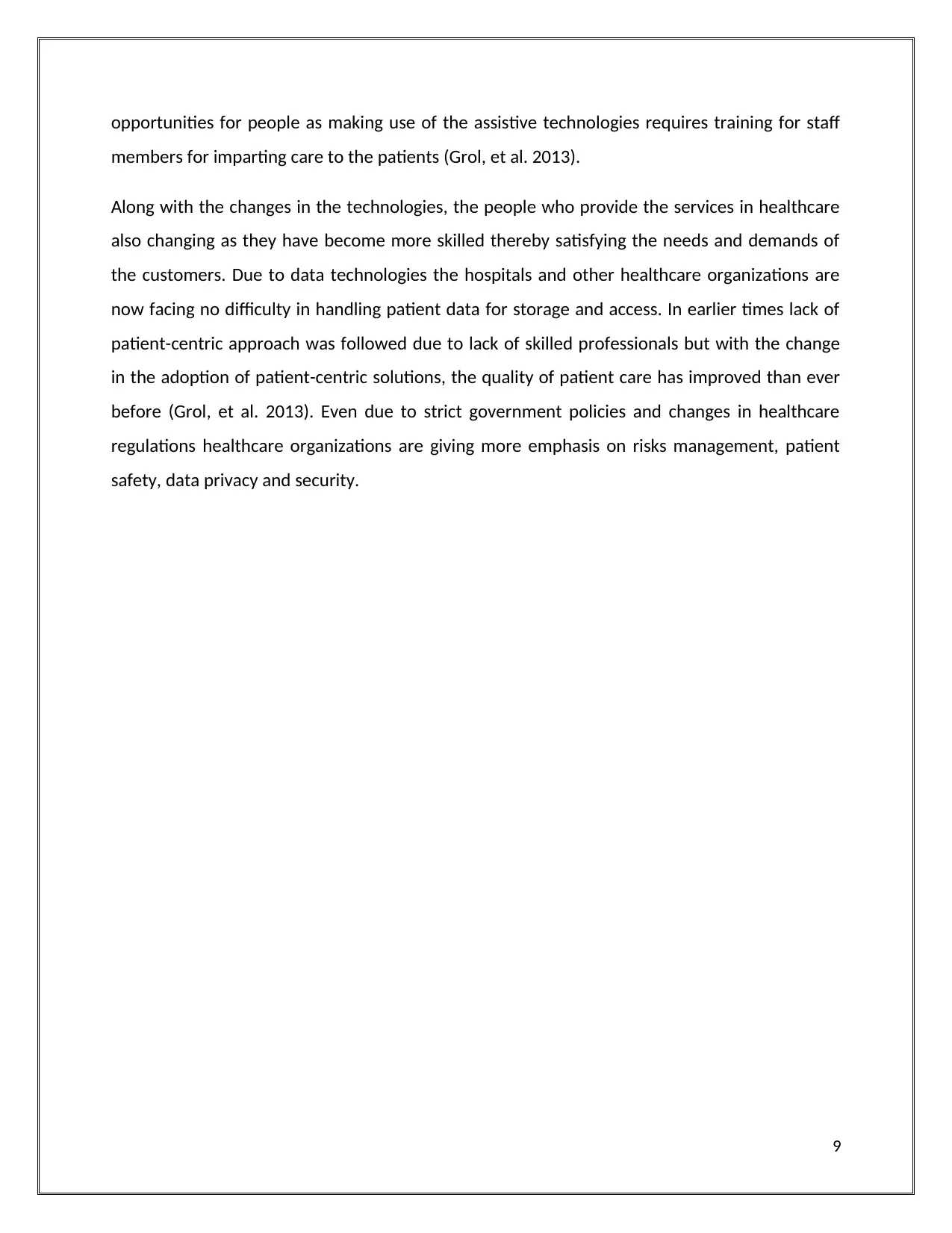
opportunities for people as making use of the assistive technologies requires training for staff
members for imparting care to the patients (Grol, et al. 2013).
Along with the changes in the technologies, the people who provide the services in healthcare
also changing as they have become more skilled thereby satisfying the needs and demands of
the customers. Due to data technologies the hospitals and other healthcare organizations are
now facing no difficulty in handling patient data for storage and access. In earlier times lack of
patient-centric approach was followed due to lack of skilled professionals but with the change
in the adoption of patient-centric solutions, the quality of patient care has improved than ever
before (Grol, et al. 2013). Even due to strict government policies and changes in healthcare
regulations healthcare organizations are giving more emphasis on risks management, patient
safety, data privacy and security.
9
members for imparting care to the patients (Grol, et al. 2013).
Along with the changes in the technologies, the people who provide the services in healthcare
also changing as they have become more skilled thereby satisfying the needs and demands of
the customers. Due to data technologies the hospitals and other healthcare organizations are
now facing no difficulty in handling patient data for storage and access. In earlier times lack of
patient-centric approach was followed due to lack of skilled professionals but with the change
in the adoption of patient-centric solutions, the quality of patient care has improved than ever
before (Grol, et al. 2013). Even due to strict government policies and changes in healthcare
regulations healthcare organizations are giving more emphasis on risks management, patient
safety, data privacy and security.
9
Paraphrase This Document
Need a fresh take? Get an instant paraphrase of this document with our AI Paraphraser
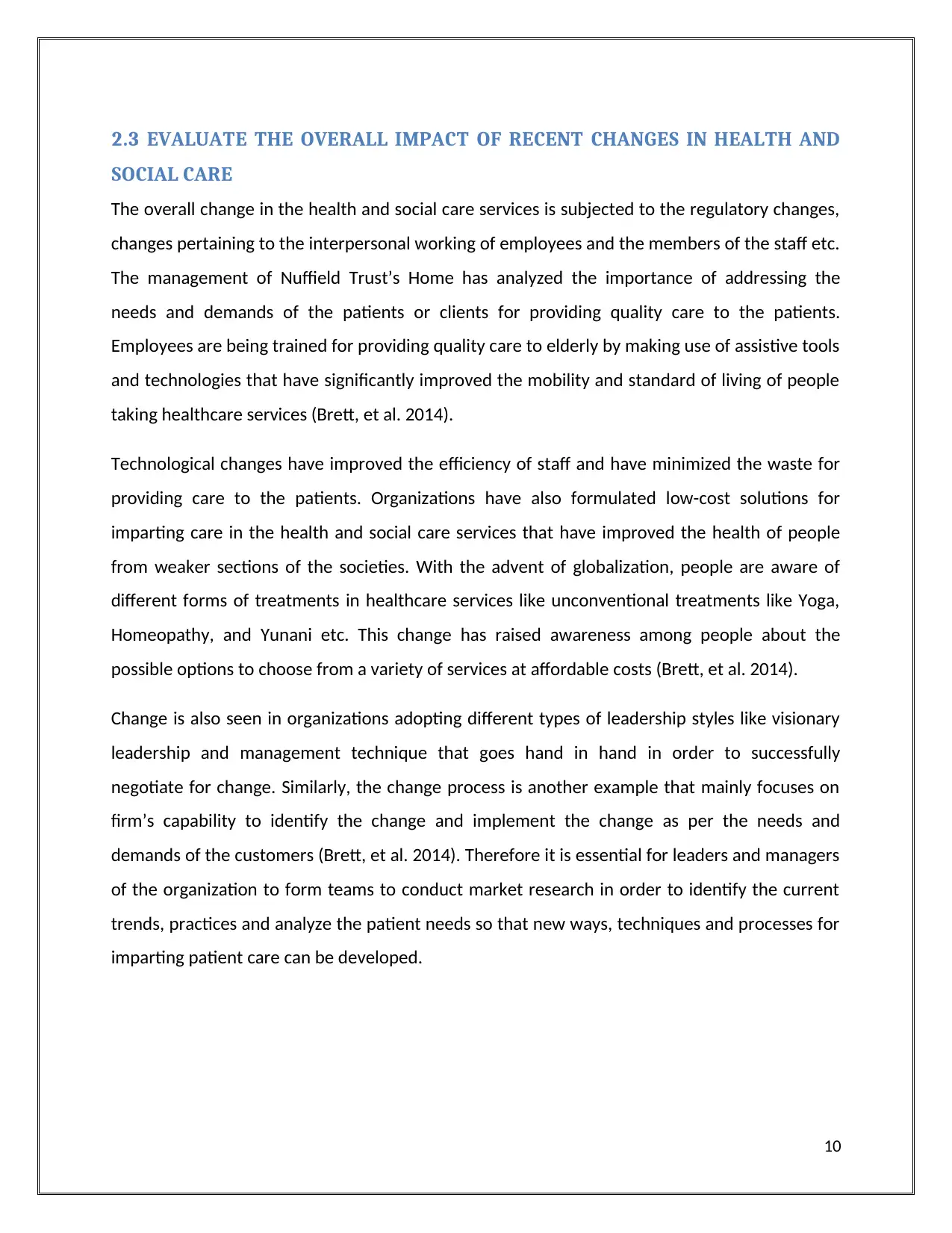
2.3 EVALUATE THE OVERALL IMPACT OF RECENT CHANGES IN HEALTH AND
SOCIAL CARE
The overall change in the health and social care services is subjected to the regulatory changes,
changes pertaining to the interpersonal working of employees and the members of the staff etc.
The management of Nuffield Trust’s Home has analyzed the importance of addressing the
needs and demands of the patients or clients for providing quality care to the patients.
Employees are being trained for providing quality care to elderly by making use of assistive tools
and technologies that have significantly improved the mobility and standard of living of people
taking healthcare services (Brett, et al. 2014).
Technological changes have improved the efficiency of staff and have minimized the waste for
providing care to the patients. Organizations have also formulated low-cost solutions for
imparting care in the health and social care services that have improved the health of people
from weaker sections of the societies. With the advent of globalization, people are aware of
different forms of treatments in healthcare services like unconventional treatments like Yoga,
Homeopathy, and Yunani etc. This change has raised awareness among people about the
possible options to choose from a variety of services at affordable costs (Brett, et al. 2014).
Change is also seen in organizations adopting different types of leadership styles like visionary
leadership and management technique that goes hand in hand in order to successfully
negotiate for change. Similarly, the change process is another example that mainly focuses on
firm’s capability to identify the change and implement the change as per the needs and
demands of the customers (Brett, et al. 2014). Therefore it is essential for leaders and managers
of the organization to form teams to conduct market research in order to identify the current
trends, practices and analyze the patient needs so that new ways, techniques and processes for
imparting patient care can be developed.
10
SOCIAL CARE
The overall change in the health and social care services is subjected to the regulatory changes,
changes pertaining to the interpersonal working of employees and the members of the staff etc.
The management of Nuffield Trust’s Home has analyzed the importance of addressing the
needs and demands of the patients or clients for providing quality care to the patients.
Employees are being trained for providing quality care to elderly by making use of assistive tools
and technologies that have significantly improved the mobility and standard of living of people
taking healthcare services (Brett, et al. 2014).
Technological changes have improved the efficiency of staff and have minimized the waste for
providing care to the patients. Organizations have also formulated low-cost solutions for
imparting care in the health and social care services that have improved the health of people
from weaker sections of the societies. With the advent of globalization, people are aware of
different forms of treatments in healthcare services like unconventional treatments like Yoga,
Homeopathy, and Yunani etc. This change has raised awareness among people about the
possible options to choose from a variety of services at affordable costs (Brett, et al. 2014).
Change is also seen in organizations adopting different types of leadership styles like visionary
leadership and management technique that goes hand in hand in order to successfully
negotiate for change. Similarly, the change process is another example that mainly focuses on
firm’s capability to identify the change and implement the change as per the needs and
demands of the customers (Brett, et al. 2014). Therefore it is essential for leaders and managers
of the organization to form teams to conduct market research in order to identify the current
trends, practices and analyze the patient needs so that new ways, techniques and processes for
imparting patient care can be developed.
10
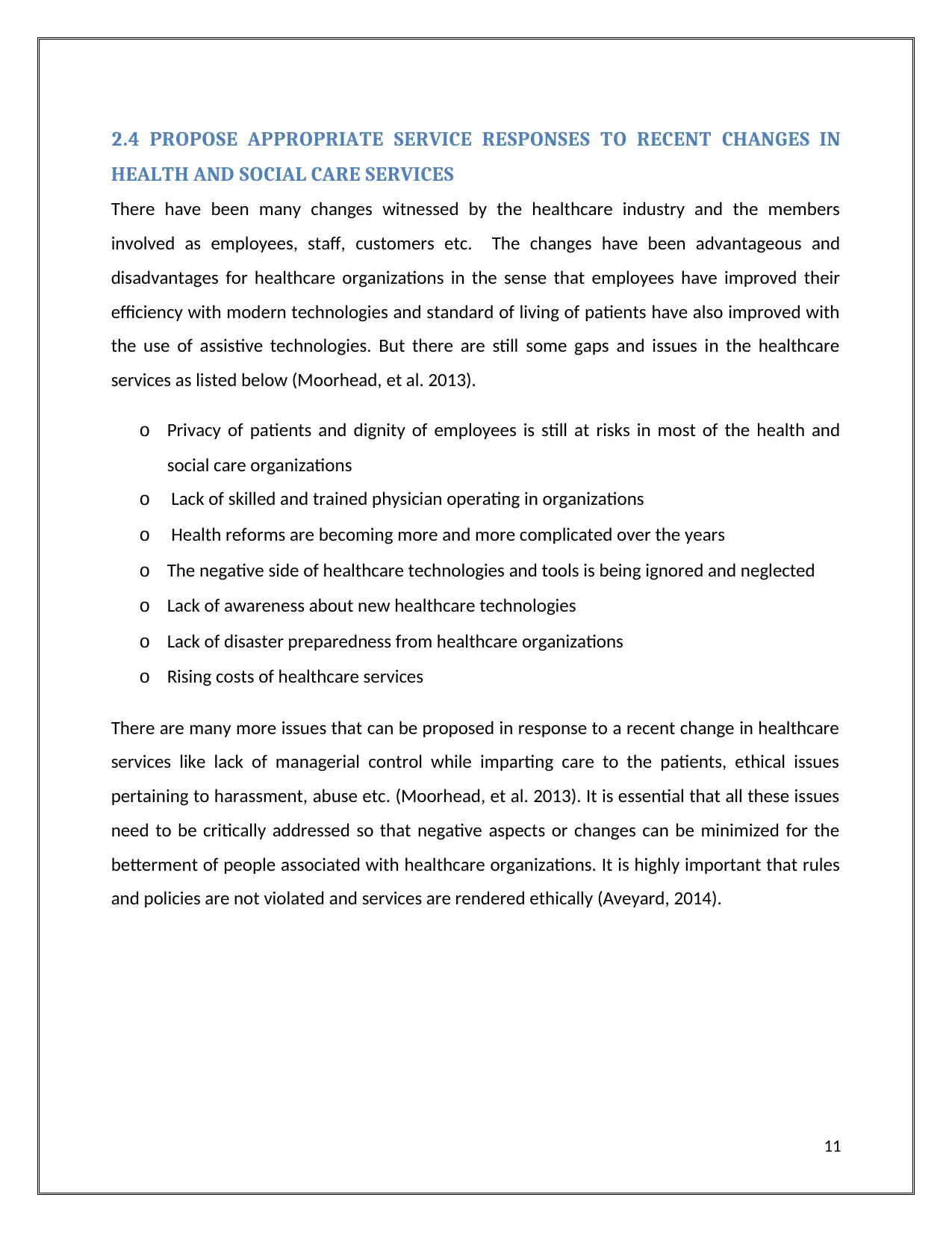
2.4 PROPOSE APPROPRIATE SERVICE RESPONSES TO RECENT CHANGES IN
HEALTH AND SOCIAL CARE SERVICES
There have been many changes witnessed by the healthcare industry and the members
involved as employees, staff, customers etc. The changes have been advantageous and
disadvantages for healthcare organizations in the sense that employees have improved their
efficiency with modern technologies and standard of living of patients have also improved with
the use of assistive technologies. But there are still some gaps and issues in the healthcare
services as listed below (Moorhead, et al. 2013).
o Privacy of patients and dignity of employees is still at risks in most of the health and
social care organizations
o Lack of skilled and trained physician operating in organizations
o Health reforms are becoming more and more complicated over the years
o The negative side of healthcare technologies and tools is being ignored and neglected
o Lack of awareness about new healthcare technologies
o Lack of disaster preparedness from healthcare organizations
o Rising costs of healthcare services
There are many more issues that can be proposed in response to a recent change in healthcare
services like lack of managerial control while imparting care to the patients, ethical issues
pertaining to harassment, abuse etc. (Moorhead, et al. 2013). It is essential that all these issues
need to be critically addressed so that negative aspects or changes can be minimized for the
betterment of people associated with healthcare organizations. It is highly important that rules
and policies are not violated and services are rendered ethically (Aveyard, 2014).
11
HEALTH AND SOCIAL CARE SERVICES
There have been many changes witnessed by the healthcare industry and the members
involved as employees, staff, customers etc. The changes have been advantageous and
disadvantages for healthcare organizations in the sense that employees have improved their
efficiency with modern technologies and standard of living of patients have also improved with
the use of assistive technologies. But there are still some gaps and issues in the healthcare
services as listed below (Moorhead, et al. 2013).
o Privacy of patients and dignity of employees is still at risks in most of the health and
social care organizations
o Lack of skilled and trained physician operating in organizations
o Health reforms are becoming more and more complicated over the years
o The negative side of healthcare technologies and tools is being ignored and neglected
o Lack of awareness about new healthcare technologies
o Lack of disaster preparedness from healthcare organizations
o Rising costs of healthcare services
There are many more issues that can be proposed in response to a recent change in healthcare
services like lack of managerial control while imparting care to the patients, ethical issues
pertaining to harassment, abuse etc. (Moorhead, et al. 2013). It is essential that all these issues
need to be critically addressed so that negative aspects or changes can be minimized for the
betterment of people associated with healthcare organizations. It is highly important that rules
and policies are not violated and services are rendered ethically (Aveyard, 2014).
11
⊘ This is a preview!⊘
Do you want full access?
Subscribe today to unlock all pages.

Trusted by 1+ million students worldwide
1 out of 22
Related Documents
Your All-in-One AI-Powered Toolkit for Academic Success.
+13062052269
info@desklib.com
Available 24*7 on WhatsApp / Email
![[object Object]](/_next/static/media/star-bottom.7253800d.svg)
Unlock your academic potential
Copyright © 2020–2025 A2Z Services. All Rights Reserved. Developed and managed by ZUCOL.




